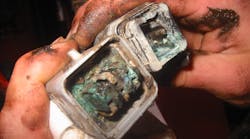There is a significant difference between electrical diagnosis and mechanical diagnosis. There is also a considerable disparity in the manner in which electrical and mechanical repairs are made.
A mechanical diagnosis usually will take minutes, with the repair lasting for hours or days. Conversely, an electrical diagnosis can take hours, with the resulting repair usually taking minutes.
While this is well understood, the contrast is seldom prioritized. Why else would there be standard repair times (SRT) for mechanical repairs but not for diagnoses?
Mechanical problems are solved with parts in a practical timeframe that can be predicted. But when facing an electrical fault, the correct process is usually 99 percent thinking and 1 percent “wrenching.”
Pointless Questions
The two most absurd questions in electrical work are: “What’s wrong?” and “How long will it take to fix?” These are extremely difficult, if not impossible, to answer because of the time-inverted nature of electrical diagnosis.
A harassed technician is less likely to find an electrical fault and make a proper repair if he’s stressed out. He’s more likely to do whatever is “necessary” to “get it running.”
By way of example, a sliced wiring harness is really a mechanical repair. Never mind that wires are involved. The process is: 1) look, 2) order and 3) replace.
But if a pierced wire corrodes, the still-accepted (but flawed) expectation that the electrical diagnosis also should take minutes puts huge pressure on the technician. If his toolbox contains a sharp, pointed “test light” diagnostic tool, he’ll likely use it.
Why? Because few have taken the initiative to manage the problem.
The Challenge of Fault Finding
Truck manufacturers write a multitude of procedures for finding faults in their electrical systems, even though there are really only three possible wire faults: open, short-to-ground and high resistance. In spite of this simplicity, each OEM’s diagnostic flowcharts are essentially unique or agonizingly redundant.
Instead of one method for finding the common faults, there are dozens. This unnecessary diversity of methodology is a serious problem because it makes it nearly impossible for a technician’s superior hands-on learning style to work.
For some reason, engineers bury the basics of each OEM’s electrical system operation in a long and confusing logic tree. It’s no wonder a pressured technician will grab a test light and start stabbing in the hopes of quickly stumbling across an answer.
Every OEM strongly advises against this destructive practice because it destroys the integrity of vehicle electrical systems.
Any tiny poke hole could lead to a huge series of problems that could render these vehicles useless (unprofitable) for days or weeks. Corrosion will inevitably find its way into connectors, wires and possibly expensive sensors and ECMs.
These issues may not surface for weeks. But when they do crop up, the truck most likely won’t be sitting in a yard. It will be in the middle of nowhere with an urgent load onboard.
If your shop practices don’t prevent “poking” from happening, the laws of physics dictate the result of pierced vehicle wire insulation: damage to the wiring and electrical system from water and chemical intrusion, including corrosion and crossed-circuits in connectors and harnesses, all of which are fatal to electronics and exceedingly difficult to find.
The laws of economics and business dictate the other outcomes from wasteful and non-productive diagnostics: unnecessary parts replacement and disabled and idle trucks.
Vehicle electrical system faults are well-understood by electrical engineers, so why is there no industry-standard electrical diagnostic process?
Time For a Change
For the average vehicle technician to succeed in the world of high-tech electronic vehicles, shop management has to take into consideration the flipped electrical diagnostic/repair times. Learning only occurs during the electrical diagnosis, which takes time, not during the repair, which typically can be done in short order.
The cheapest training you can pay for is not only simply letting the technician sit and read about the electrical system, circuits and components before starting the job, but encouraging this and participating. This will allow skills and knowledge of both the technician and the supervisor to grow. That, in turn, will lead to shortened diagnostic times.
Dan Sullivan is a licensed aircraft mechanic who has taught electrical diagnostics to more than 6,000 technicians in the trucking, equipment, marine, aviation and mining industries since 1996 through his company, Sullivan Training Systems (http://brighterideas.com). He has authored books on electrical diagnostics and electric power generation, and has U.S. and EU patents for diagnostic tools adopted by Caterpillar, Volvo and UPS. His YouTube channel has more than 75 electrical videos.


